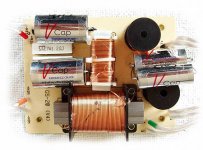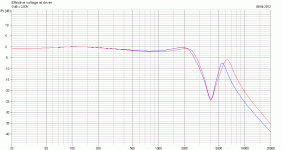From what I remember:
1. Lowering crossover frequency with 6uF on tweeter.
2. 4uF on the midwoofer, now available from tweeter, gives a better handling at lower crossover band.
3. And finally the second order for the woofer, to prevent some of the breakup.
You can find a crossover I designed a little wild ago, that had that in mind, with 2xDynavox LW6004PMR 6-1/2" woofers and a Vifa DX25TG-05-04 tweeter.
http://www.diyaudio.com/forums/multi-way/163796-some-design-help-please.html#post2131776
Hi,
Its all pure conjecture with no evidence that it will be better.
Though swapping the two capacitors can't hurt or damage
anything, there is no reason to assume its an improvement,
and cogent reasoning to suggest it will be somewhat worse,
especially regarding phase tracking at the x/o point.
Second order on the woofer is a very bad idea. Its there
for BSC correction and a shallow slope is needed. What
is a good idea is taking it out of the cabinet and putting
some pink noise 1/3 bands through it. It will become
apparent if the driver has any break up issues or not.
If it does add a parallel trap filter you know will work,
based on the problem frequency you have identified.
Conjecture is not right until proved wrong,
it is very much the other way round sensibly.
A page full of impressive arguments as to what might be better is
meaningless if the original crossover has been carefully optimised.
That doesn't mean it can't be made better at more cost, but save
me the handwaving that implies that "whatever" must be better.
IMO there is a very limited number of things you can sensibly do given
the information, to adjust tonal balance and they have been suggested.
Anything more radical based on conjecture is a crapshoot, usually worse.
rgds, sreten.
Inductors values are not known, driver responses are not known, driver
impedances are not known, baffle ripple effects not considered, etc ...
Last edited:
From "Monitors" (Monitor Audio) they only have the name.
I don't agree that "commercial development" (I mention here some problems; new materials, number of units sold in big quantities, buzzing tweeters to impress the client, not good enough crossover design) and pushing marketing will deliver very good results in the R&D department.
Maybe this works...
Is it really modified? Or it's just the looks...
Monitor Audio GS-20 crossover, Modified by Pierre Krebs
V-Cap comments by Pierre Krebs
I don't agree that "commercial development" (I mention here some problems; new materials, number of units sold in big quantities, buzzing tweeters to impress the client, not good enough crossover design) and pushing marketing will deliver very good results in the R&D department.
Maybe this works...
Is it really modified? Or it's just the looks...
Monitor Audio GS-20 crossover, Modified by Pierre Krebs
V-Cap comments by Pierre Krebs
Attachments
Air core inductors sound better. There are no graphs to prove it though.
Speakers - More than meets the eye (Part 1)
Speakers - More than meets the eye (Part 1)
I don't agree that "commercial development" ......
will deliver very good results in the R&D department.
Hi,
Neither does pure conjecture and blind faith in "wondercaps".
rgds, sreten.
Hi,
Neither does pure conjecture and blind faith in "wondercaps".
rgds, sreten.
Those aren't just Wondercaps though, those are "Reference Grade"!
So, what can we say about this?
Your reduced capacitor is the red trace.reducing the capacitance in a second order low pass filter increases damping but also increases the higher frequency content.
Attachments
...Given the x/o appears to be high pass 1st order at ~ 9KHz I'd...There is a "better" version, for those that prefer more even tonality :.....Conversely you can't waffle on about features properly built into good x/o's as though they are wrong because they are "not right" without
enough information, in my book that is arrogant and ignorant.
S7's comments and suggested "improvements" are wrong.
SB wisely hasn't bought into being handed a loaded .
I belive we should leave the crossover alone. There is plenty to be done outside the box that can help and most of this is reversible.
Srenten, who are 'S7' and 'SB'?
Actually the opposite happens, you need to simulate to see it like I did, for my amazement..
Are you refering to the 'parallel' capacitor in the woofer's XO? I did some simulation in LsPCAD and found that increase the cap rolled of the amplitude of the midbass faster but it also affected phase.
IMO there is a very limited number of things you can sensibly do given
the information, to adjust tonal balance and they have been suggested.
Anything more radical based on conjecture is a crapshoot, usually worse...Inductors values are not known, driver responses are not known, driver
impedances are not known, baffle ripple effects not considered, etc ...
I agree. Hence shouldn't Mihai try some simple "tweaks" first.
Yes. Refer to posts #97 and #106 for your answer see the simulations done both by me and AllenB with the obvious commentaries.Are you refering to the 'parallel' capacitor in the woofer's XO? I did some simulation in LsPCAD and found that increase the cap rolled of the amplitude of the midbass faster but it also affected phase.
Phase is affected lightly. (This is w. such a small change in the cap value.)
Use clarity caps (SA or better), replace the 1,2 ohm resistors with 2,7 ohm, replace midwoofer inductor with goertz 0,58 - 0,6 mH 12awg, or 14awg if you like treble / bass.
(and maybe replace tweeters with Seas tffc, (-haven`t tried)).
Give it some days and the speakers goes crazy, - its heaven.
(and maybe replace tweeters with Seas tffc, (-haven`t tried)).
Give it some days and the speakers goes crazy, - its heaven.
Looking on graphs from Stereophile the best upgrade is to reduce output in highs. L-pad is not a good idea -I wanna take your advice and do some measuring on drivers.
This is what I found as a combo at a very good price (80eur):
Preamplificator microfon Behringer MIC100 (147,26RON) Partysound
Microfon Omnidirectional de masura Behringer ECM8000 (202,78RON) Partysound
Can I get your short guide on making useful loudspeaker measurements when using ARTA, please?
Thanks,
Mihai
If poject is not finished and you have equipment - make 2 measurements on-tweter axis:
1) with original crossover
2) with adding in parallel to tweeter (C=2.2uF sequetally with R=8.2Ohm)
And listen both speakers with (2) - it should take some brightnes off.
Just replacing caps to best possible can make them sound smoother, but not that much as you need according to Stereophile measurements.
The bigest upgrade you will get is with correcting freq.response in highs (2), then you can tune your crossover with better caps.
According to photos those caps look like Bennic with MA logo. Just replacing them to cheap Mundorf MCap will bring positive changes, but first you need to correct response. My personal choise for this crossover could be MCap400 for mid and Auricap XO for tweeter.
And upgrading speakers without proper software/equipment and calibrated microphone: you are blind and do not see what you really get. Ears in most cases adopts to get flat response in the brain - takes some seconds or minutes of listening and you think that job is done, but next day you listen again and start to do something with crossover again and again.
MA GS20...
Replacing caps with higher voltage (630v?) makes a big improvemant. All caps should have the same voltage. I have measured the MidBass inductor to 0,585 mH / +-0,06 ohm. It`s an ironcore inductor and I dont like ironcore in the mids. Try Goertz 12AWG (0,083 ohm), it makes a houge improvement. I am going to replace the Tweeters with a softdome (SEAS TFFC) also, -softdomes sounds better than metaldomes in my ears..
(I have an MF M3i amplifier)
Replacing caps with higher voltage (630v?) makes a big improvemant. All caps should have the same voltage. I have measured the MidBass inductor to 0,585 mH / +-0,06 ohm. It`s an ironcore inductor and I dont like ironcore in the mids. Try Goertz 12AWG (0,083 ohm), it makes a houge improvement. I am going to replace the Tweeters with a softdome (SEAS TFFC) also, -softdomes sounds better than metaldomes in my ears..
(I have an MF M3i amplifier)
- Status
- This old topic is closed. If you want to reopen this topic, contact a moderator using the "Report Post" button.
- Home
- Loudspeakers
- Multi-Way
- Please help for Monitor Audio GS20 crossover tuning

